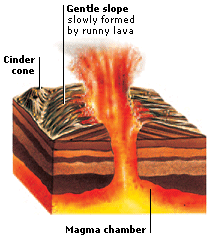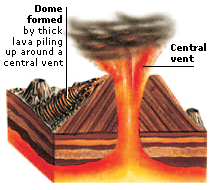DK Science: Volcanoes
Volcanoes are vents (openings) in the ground from which magma (molten rock), ash, gas, and rock fragments surge upwards, in an event called an eruption. They are often found at boundaries between the plates in Earth’s crust. Volcanic eruptions produce volcanoes of different shapes, depending on the type of eruption and the region’s geology. HYDROTHERMAL ACTIVITY occurs where underground water is heated by rising magma.

Magma that flows over the Earth's surface is called lava. A shield volcano produces lava that spreads over a wide area to form a broad mound. Magma collects underground in a space called a magma chamber, before erupting through vents to form low cones, and through fissures (long cracks).

A dome, or cone, volcano is formed when thick, sticky lava erupts from a volcano crater. The lava cools and solidifies quickly to form a dome. Further eruptions may add more layers. The collapse of a dome can produce dangerous pyroclastic flows – fast-moving flows of hot gas and volcanic fragments.

A steep-sided composite volcano is made of alternating layers of ash and lava, produced by a series of eruptions. Its thick magma does not flow far before solidifying. This type of volcano often has a main vent, fed by a chimney rising from its magma chamber, and additional side vents.
Magma forms when the rocks below the Earth’s crust melt. A flow of erupted magma along the Earth’s surface is called lava. When red-hot lava flowing from volcanoes cools, it solidifies into many different forms. One, pahoehoe lava, is fast-flowing and runny. As it cools, it forms a smooth, shiny skin, under which lava continues to flow. This sometimes wrinkles the smooth surface into ropelike coils.
Unlike smooth-skinned pahoehoe lava, aa lava has a rough surface, which is difficult to walk on and sharp enough to rip rubber shoes. This jagged material is formed when slow-moving, sticky lava cools and breaks up into sharp, blocky shapes. Flows of aa lava can be thick, reaching heights of up to 100 m (330 ft). The words for aa (pronounced ah-ah) and pahoehoe (pahow-ee-how-ee) lava come from Hawaii, where these lava types occur and were first studied.
The word “hydrothermal” comes from the Greek words for water and heat. In volcanic regions, the combination of heat and water below ground produces remarkable effects. In the oceans, openings called hydrothermal vents form when cracks containing red-hot magma fill with seawater. They spout black clouds of hot water mixed with gas and minerals. Hydrothermal activity on land produces hot springs, geyser, and pools of bubbling mud.
